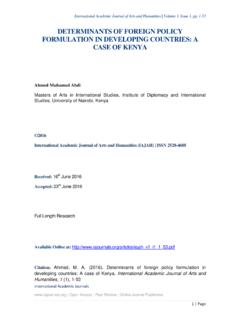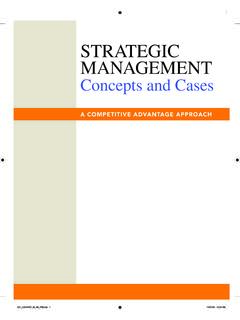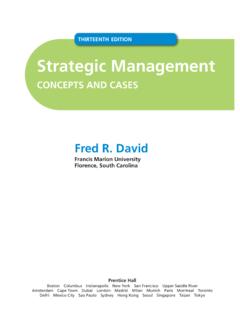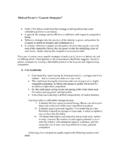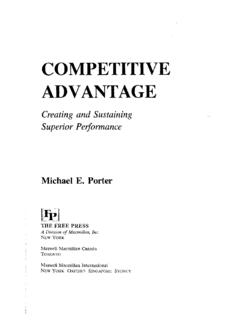Transcription of STRATEGIC MANAGEMENT PRACTICES AND …
1 International Academic Journal of Human Resource and Business Administration | Volume 3, Issue 1, pp. 1-26 1 | P a g e STRATEGIC MANAGEMENT PRACTICES AND PERFORMANCE OF SMALL AND MICRO ENTERPRISES IN NAIROBI CITY COUNTY, KENYA Ali Khalif Gure Master of Business Administration ( STRATEGIC MANAGEMENT ), Kenyatta University, Kenya Dr. Janesther Karugu Department of Business Administration, Kenyatta University, Kenya 2018 International Academic Journal of Human Resource and Business Administration (IAJHRBA) | ISSN 2518-2374 Received: 1st January 2018 Accepted: 4th January 2018 Full Length Research Available Online at: Citation: Gure, A. K. & Karugu, J. (2018). STRATEGIC MANAGEMENT PRACTICES and performance of small and micro enterprises in Nairobi City County, Kenya.
2 International Academic Journal of Human Resource and Business Administration, 3(1), 1-26 International Academic Journal of Human Resource and Business Administration | Volume 3, Issue 1, pp. 1-26 2 | P a g e ABSTRACT Small and Medium Enterprises (SMEs) is an important sub sector for the Kenyan economy like many other developing countries since it employs about 85% of the Kenyan workforce (about Kenyans of the current total employment). The current constitutional framework and the new Micro and Small Enterprise Act 2012 provide a new window of opportunity through which the evolution of SMEs can be realized through the devolution framework. However, the impact of devolution on SMEs development depends on the architecture of the regulatory and institutional framework inclined to support SMEs in an economy.
3 Lack of access to credit is a major constraint inhibiting the growth of SMEs sector. The issues and problems limiting SMEs acquisition of financial services include lack of tangible security coupled with inappropriate legal and regulatory framework that does not recognize innovative strategies for lending to SMEs. The study sought to establish the influence of STRATEGIC MANAGEMENT PRACTICES on the organizational performance of SMEs in Nairobi City County, Kenya. The specific objectives were to determine the effect of low cost leadership strategy, differentiation strategy, focus strategy and combination strategies on performance of SMEs in Nairobi City study was anchored on the following three theories which include Porter s generic strategies model, resource-based view theory, and resource dependence theory.
4 Empirical literature reviewed scholarly studies on the porter s generic competitive strategies which included cost leadership strategy, differentiation strategy,focus strategyand combination strategies and their influence on financial performance of SMEs. The study used a descriptive research design. The population of study wre youth owned SMEes in the 17 sub-counties in Nairobi City County that are operational. This consisted of 100 respondents who were the proprietors of the enterprises. A sample of 30 respondents was taken which formed 30% of the target population which was evenly spread across the sub-counties. The primary data was collected by use of self-administered semi-structured questionnaire.
5 Data analysis was done by use of descriptive statistics such as frequencies, percentages, mean scores and standard deviation with the aid of SPSS and presented through tables, charts, graphs, frequencies and percentages. The study realized that the michael Porter s generic strategies of competitive advantage used in the study which include low cost leadership strategy, differentiation strategy, focus strategy and combination strategy significantly influenced the organizational performance of SMEs in Nairobi City County, Kenya. The variables explained of the changes in organizational performance of the SMEs. A unit increase in low cost leadership strategy adoption by SMEs led to a increase in organizational performance of the SMEs, a unit increase in differentiation strategy adoption led to a increase in performance of the enterprises, a unit increase in focus strategy transformed to a increase in performance of the firms while a unit increase in application of combination strategy by the SMEs led to a International Academic Journal of Human Resource and Business Administration | Volume 3, Issue 1, pp.
6 1-26 3 | P a g e increment in their overall performance. Key Words: STRATEGIC MANAGEMENT PRACTICES , performance, small and micro enterprises, Nairobi City County, Kenya INTRODUCTION STRATEGIC MANAGEMENT is a concept that concerns making decisions and taking corrective actions to achieve long-term targets and goals of an organization (Bakar et al, 2011). It is a set of decisions and actions that result in the formulation and implementation of plans designed to achieve a company s objectives (Pearce & Robinson, 2008). The business environment in which firms operate is dynamic and turbulent with constant and fast paced changes that often render yester-yearsstrategies irrelevant (Ofunya,2013). strategies should therefore be put in place to cushion the businesses from the uncertainty that comes along with an unpredictable environment.
7 STRATEGIC MANAGEMENT addresses the reason why some organizations succeed while others fail (Melchorita, 2013; Porter, 2001). STRATEGIC MANAGEMENT involves identifying the organization s current mission, objectives, and strategies , analyzing the environment, identifying the opportunities and threats, analyzing the organization s resources, identifying the strengths and weaknesses, formulating and implementing strategies and evaluating the results (Robbins & Coulter, 1996). STRATEGIC MANAGEMENT practice consists of threebasicelements, strategy formulation, implementation, evaluation and control (Wheelen& Hunger, 2008). It is within these threeelements that STRATEGIC MANAGEMENT PRACTICES are manifested and is also described as the STRATEGIC MANAGEMENT process.
8 The concept of organizational performance is core to businesses because the major objective of businesses is to make profits. Iravo et. al., (2013) state that one of the important questions in business has been why some organizations succeed and why others fail and this has influenced a study on the drivers of organizational performance. Awino (2011) asserts that for an organization to be successful it has to record high returns and identify performance drivers from the top to the bottom of the organization. Njihia et. al., (2013) highlight performance measurement as one of the tools which helps firms in monitoring performance, identifying the areas that need attention, enhancing motivation, improving communication and strengthening accountability.
9 Financial institution managers, like any other managers, can use the feedback on performance to make adjustments to policies and other modes of organizational operations (Wadongo et. al., 2010). Fwaya (2006) views performance as a formula for the assessment of the functioning of an organization under certain parameters such as productivity, employee morale and effectiveness. Performance MANAGEMENT and improvement is at the heart of STRATEGIC MANAGEMENT because a lot of STRATEGIC thinking is geared towards defining and measuring performance (Nzuve and Nyaega, 2012). Odhiambo (2009) identified three approaches to performance in an organization which are the goal approach, which states that an organization pursues definite identifiable goals.
10 This approach describes performance in terms of the attainment of these goals. The second approach International Academic Journal of Human Resource and Business Administration | Volume 3, Issue 1, pp. 1-26 4 | P a g e is the systems resource approach which defines performance as a relationship between an organization and its environment. This concept defines performance according to an organization s ability to secure the limited and valued resources in the environment. The third approach is the process perspective which defines performance in terms of the behaviour of the human resource of an organization (Waiganjo et. al., 2012). According to World Bank, (2013), SMEs are the main source of employment in developed and developing countries alike, comprising over 90% of African business operations and contributing to over 50% of African employment and GDP.


